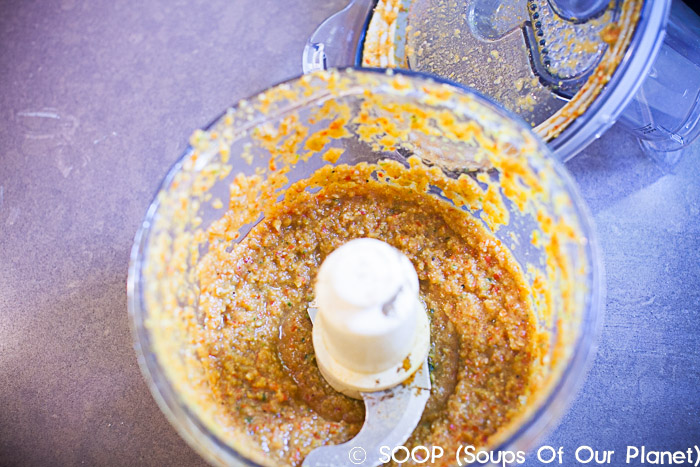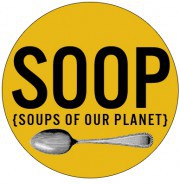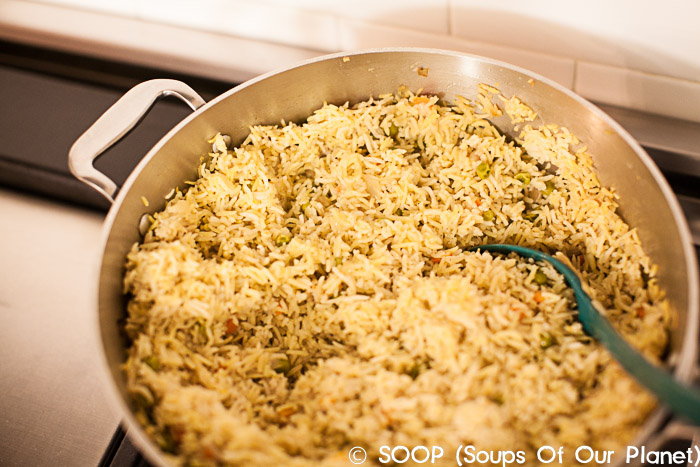NEPAL: Thukpa

 When my husband and I spent a dreamy month in Nepa before we got married (15 years ago!), our favorite meal was also (luckily) the meal we ate for breakfast, lunch and dinner: Dal Bhat*. Dal Bhat, a lentil stew served with rice, is every backpacker’s staple fare and the national dish of Nepal. Hearty, filling, and warming, it hits the spot after a long day of trekking. We love(d) it so much it also hits the spot about once a month in our house. SO, for our SOOP project this week, S is in charge of picking the soup and when I suggested Dal Bhat, he said “No way! We have that allllllll the time. I want to pick something different.” Per the rules I made for myself for how this whole project will work, the boy who picks the country out of the cup also gets to pick the soup. And pick he did. The boy loves spring rolls and picked Thukpa because he says it sounds like spring roll soup.
When my husband and I spent a dreamy month in Nepa before we got married (15 years ago!), our favorite meal was also (luckily) the meal we ate for breakfast, lunch and dinner: Dal Bhat*. Dal Bhat, a lentil stew served with rice, is every backpacker’s staple fare and the national dish of Nepal. Hearty, filling, and warming, it hits the spot after a long day of trekking. We love(d) it so much it also hits the spot about once a month in our house. SO, for our SOOP project this week, S is in charge of picking the soup and when I suggested Dal Bhat, he said “No way! We have that allllllll the time. I want to pick something different.” Per the rules I made for myself for how this whole project will work, the boy who picks the country out of the cup also gets to pick the soup. And pick he did. The boy loves spring rolls and picked Thukpa because he says it sounds like spring roll soup.
*Dal Bhat is insanely delicious and Sasha over at Global Table Adventure has a fantastic recipe that is quick, CHEAP, really close to how it tastes in Nepal and vegetarian. We eat it with basmati rice, roasted cauliflower florets that have been tossed in olive oil and curry powder, and usually a green salad. Mmm. Now I’m hungry. Might have to make this for dinner tomorrow!
Thukpa, traditionally a Tibetan soup (the name translates from Tibetan as ‘noodles’), has crossed the border into Nepal with wild abandon and is now popular all over Nepal as well as northern India. It consists of spicy broth, long thin noodles, vegetables, spices, and is found vegetarian and with every meat you can imagine (in fact, I think we may have eaten this with yak meat in Kathmandu). For our version, S chose chicken, rice noodles (to remain close to his spring roll vision), and carrots and cilantro. I threw in the red pepper and bean sprouts (both traditional additions) for color and texture. A few of the spices are a little hard to come by, but we’re fortunate to have many places to scoop up ethnic goods around us and we grabbed asafoetida and szechwan pepper at Oaktown Spice Shop in Oakland, but you can also find the spices online at Penzeys and Kalustyan’s.

1999 Mustang, Nepal Trek Day 7: Marang (Chogo) La Pass – 13,878 feet / 4,230 meters. I hiked in a skirt to be more respectful of the local culture. I looked goooood didn’t I?
During our month in Nepal, we spent many long hours with our guides learning about Nepali cuisine, culture and language and teaching them important things like the game of spoons and various card tricks. A few of the phrases we learned have stuck with us through the years and my husband is known to say to me as I approach some arduous task (hiking up a steep trail, folding the week’s laundry, getting the kids in the car on time in the morning), “Lahk bahk, didi. Lahk bahk!” (Translation almost there, big sister. Almost there!). Another phrase we use all the time is “Ookus mookus”. It means, essentially, I am so full I am about to explode.

From the left, the King of Mustang, our government liaison, us, and our guide Bhim Bahadur Lama. Jigme Palbar Bista, the last king of the remote kingdom of Mustang in Nepal’s Himalayas, was born around 1930 in Lo Manthang, once the capital of the former Tibetan kingdom of Lo. The youngest son of King Angun Tenzing Tandul, he inherited the throne in 1964. He likes orange Tang and is most grateful if you bring him some when visiting.
So, friends, with that we’ll get to cooking and (hopefully) by the end we will all be Ookus mookus! To really get in the mood, create a Pandora station with the artist Udit Narayan or download THIS album. We bought this album on the streets of Kathmandu and listened to it during both of our boys’ births and groove out to it all the time. I hope you like it as much as we do.

1999 Boudhanath Stupa, Kathmandu and rain clouds in the background. We got very wet that day.

Nepalese Thukpa
Serving: 4-6
Spice paste
- 1 small onion, chopped
- 2 garlic cloves, chopped
- 1 tsp fresh ginger, chopped
- 1 tsp ground cumin
- ½ tsp ground turmeric
- ¼ tsp ground Szechwan pepper
- 1 pinch asafoetida powder
- 1-3 jalapeño chili, deseeded, chopped (depending on how spicy you want it)
- 1 tbsp cilantro, chopped
- 1 tbsp fresh lime juice
- 1 large tomato, chopped
Soup
- 1 tbsp ghee
- 8 cups chicken stock
- ½ lb skinless/boneless chicken thighs
- 300 g rice noodles
- 1 large carrot, cut into thin matchsticks
- ½ red bell pepper, thinly sliced
- 1 cup mung bean sprouts
- 1 tbsp lemon juice
- salt and pepper, to taste
- chopped cilantro, to serve
- nepali chili sauce, to serve (recipe below)
Instructions
- To make the spice paste, combine all the ingredients, except the tomatoes, in a blender or food processor and process until minced. Then add the tomatoes and process again until combined into a rough paste.


- Heat the ghee in a large saucepan over medium heat. Add the spice paste and cook, stirring constantly, for 5 minutes, until quite aromatic and the paste becomes soft.

- Carefully pour in the chicken stock (it may sizzle at first) and bring to a boil. Reduce the heat and simmer for 15 minutes. Add the chicken thighs and simmer gently for 10 minutes, or until chicken is cooked through. Remove chicken from the stock and roughly shred.

- Meanwhile, bring large pot of water to boil. Add rice noodles and cook for 2 minutes or until al dente. Drain and rinse in cold water. Drain again and set aside.


- Add the carrot, bell pepper, and mung bean sprouts to the soup and simmer for 2–3 minutes, until the vegetables are just tender.

- Add lemon juice and season to taste – adding more salt or pepper as necessary.
- Divide the noodles between bowls (for pretty presentation, mound the noodles all on one side of the bowl) and top with the shredded chicken. Ladle the stock and vegetables over the noodles and top with chopped cilantro. Serve with chili sauce.

* Asafoetida and Szechwan pepper can generally both be found in spice stores online as well as local Indian markets. The traditional pepper used in Nepali Thukpa (timur) is currently unavailable in the United States, but Szechwan pepper provides a similar tongue tingling spice. Traditionally, it is served with a vinegary chili sauce. Here is the one we made and used:
Garlicky Red Chili Hot Sauce (pictured above with the ingredients for Thukpa)
Yield: 2 cups (aka: enough to last you a very, very, very long time)
Recipe by Melissa Clark printed in the NYTimes 8/25/10
- 4 hot red or orange chili peppers, such as habañero
- 2 red bell peppers (3/4 pound), roughly chopped
- 5 garlic cloves, roughly chopped
- 3/4 cup distilled white vinegar
- 1/2 teaspoon kosher salt.
- Wearing rubber or latex gloves, roughly chop the chilies. Combine all ingredients in a small pot over medium-high heat. Once mixture is simmering, reduce heat to low, cover and continue to simmer until peppers are tender, 7 to 10 minutes. Do not inhale vapors; they will sting.
- Transfer mixture to a blender and purée. Pour into a medium jar and allow to cool uncovered. Cover tightly and refrigerate for three days. Keep stored in refrigerator; sauce will last for several weeks or months.
THE MEAL:
This is officially my first favorite soup. It was quick, flavorful, filling, inexpensive, and fun. We found that the Chili sauce was absolutely necessary for the tongue tingling fun. If you don’t have the time or the desire to make your own, sriracha would be a nice option.
Our good friends joined us as we blasted Bollywood tunes, and slurped noodles to our hearts content. Our thukpa was served on the metal plates we picked up years ago in India with basmati rice, melon, and a chopped cauliflower that we roasted in the oven with a couple boxes of Trader Joes’ frozen chana masala (chickpea curry). It’s one of my favorite Trader Joe’s dinner hacks. Our meal got 3 thumbs up and one medium thumb (perhaps because it was his brother who made it and he simply can’t approve of anything his brother does right now) so I’m going to say it was a success!


 After dinner, we pulled out our slide projector and, once we finished answering the questions about what a slide projector is and how our photos are on the little pieces of plastic (called film), ran through some of the hundreds of slides we took in Nepal. What a wonderful way to cap off the night – the boys learned more about Nepal, about our trip, and about the history of photography.
After dinner, we pulled out our slide projector and, once we finished answering the questions about what a slide projector is and how our photos are on the little pieces of plastic (called film), ran through some of the hundreds of slides we took in Nepal. What a wonderful way to cap off the night – the boys learned more about Nepal, about our trip, and about the history of photography.

Oh, the irony. We covered our TV with a white sheet to be able to show our slides. We are so retro that way!
 Here’s what we learned about Bulgaria in our research this week:
Here’s what we learned about Bulgaria in our research this week: Apparently, it was “everyone wear red” night at our house. I didn’t even notice until processing the photos. Funny. Also, if you don’t like losing, never play Yahtzee with Calvin. He is a ringer. You have been warned.
Apparently, it was “everyone wear red” night at our house. I didn’t even notice until processing the photos. Funny. Also, if you don’t like losing, never play Yahtzee with Calvin. He is a ringer. You have been warned. Supa Topcheta (Bulgarian meatball soup) Супа топчета
Supa Topcheta (Bulgarian meatball soup) Супа топчета
































 weekend was a fantastic white from the foot of the Mátra mountains. This description from the importer nails it:
weekend was a fantastic white from the foot of the Mátra mountains. This description from the importer nails it:


































